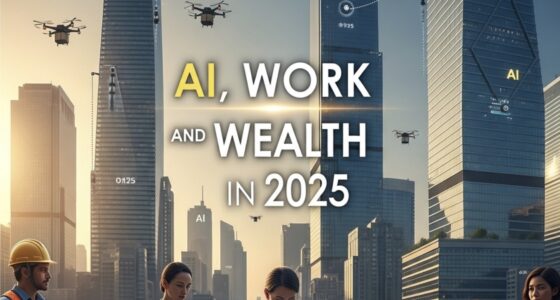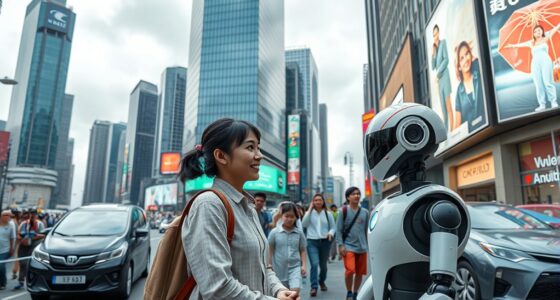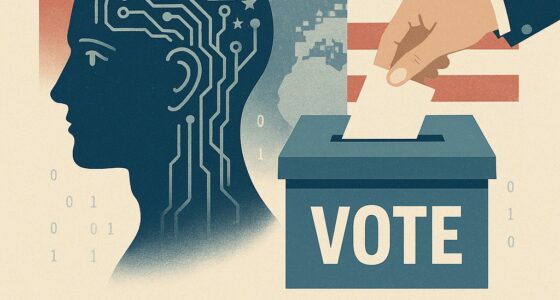Reducing work hours could boost prosperity by allowing more time for personal growth, creativity, and community engagement. Advances in automation and AI can maintain productivity while shortening workweeks, easing stress, and improving well-being. Policymakers are exploring strategies like universal basic income and flexible jobs to support this shift. If you want to discover how technological and social innovations might shape a more prosperous, less work-dependent society, there’s much more to explore.
Key Takeaways
- Automation and AI can enable shorter workweeks while maintaining productivity, increasing leisure and personal time.
- Reduced work hours may lower stress, improve mental health, and enhance overall societal well-being.
- Digital financial tools and secure payment systems support economic resilience during a transition to less work.
- Policy innovations like UBI can ensure income stability, facilitating prosperity in a less work-dependent economy.
- Emphasizing skill development and workforce adaptation fosters economic growth despite reduced traditional employment.
The Current State of Employment and Unemployment Trends

Despite ongoing economic uncertainties, the global employment landscape remains relatively stable in 2025. The OECD unemployment rate stays steady at 4.8%, a record low since March 2023, while the worldwide rate is around 4.9%, the lowest since 1991. Overall, unemployment has decreased from 6.59% in 2020 to 4.96% in 2023, with stability expected this year. However, regional disparities persist: low-income countries see slight increases in unemployment, while middle-income nations experience declines. Youth unemployment remains high at 13%, with NEET rates ranging from 10.1% in high-income to 27.6% in low-income economies. Factors like stabilizing economies and easing inflation contribute to these trends, though geopolitical issues and rising living costs continue to influence the labor market. Advances in automation technology are also reshaping job opportunities and skill requirements across various sectors.
How Unemployment Affects Society and Well-Being

Unemployment directly impacts society and individual well-being by disrupting economic stability and social cohesion. When you’re unemployed, consumer spending drops because your disposable income shrinks, slowing economic growth. This can lead to economic stagnation, with businesses cutting back and laying off more workers. It also burdens government resources, increasing reliance on social welfare and reducing tax revenues. On a social level, high unemployment raises crime rates, poverty, and social unrest, eroding community bonds. Psychologically, unemployment heightens stress, depression, and anxiety, affecting physical health and family relationships. It can cause social isolation and diminish community participation. Additionally, vetted wave and wind technologies offer promising sustainable energy alternatives that can help stimulate new job creation in the renewable sector. Investing in renewable energy can be a crucial part of economic recovery strategies. Furthermore, the development of clean energy industries can foster innovation and long-term economic resilience. Implementing personal finance management strategies, such as creating a retirement savings plan and managing irregular income, can also help individuals weather economic downturns. Recognizing the importance of job creation in diversifying local economies is essential for fostering resilience and reducing unemployment rates. Overall, unemployment weakens societal structures, hampers well-being, and complicates economic recovery, illustrating how essential employment is to a thriving, resilient society.
Rethinking Work Hours in the Age of Automation

As automation and AI transform workplaces, they open the possibility of rethinking traditional work hours. With routine tasks handled by machines, you could work fewer hours while maintaining productivity. Historical trends show that technological advances have already reduced working hours, like the 40-hour week and weekend breaks. Increased productivity from AI might allow for shorter workweeks, giving you more time for leisure or personal pursuits. Many businesses expect AI to replace human tasks gradually over the next 50 years, and workers are already retraining to adapt. However, economic systems and cultural attitudes often resist change, and wage disparities persist. technological displacement could influence half of the global economy, and to truly benefit, policies must support flexible hours, retraining, and new work models, positioning shorter workweeks as a path toward greater well-being and prosperity. Moreover, understanding the potential for technological displacement can help societies prepare for these shifts and create safety nets for displaced workers. Recognizing the importance of personal growth and development can empower individuals to navigate these changes with resilience and adaptability. Additionally, fostering innovative policies can facilitate a smoother transition to these new work paradigms, ensuring that the benefits are broadly shared. Emphasizing the value of mental health and well-being is crucial in fostering a sustainable and thriving workforce in an era of rapid technological change.
The Role of Technology in Transforming the Workforce

Have you noticed how technology is rapidly reshaping workplaces around the world? Nearly all companies are investing in AI, yet only 1% feel they’ve fully integrated it. Broadening digital access is seen as the most transformative trend by 60%, enabling new tech to reshape labor markets. AI and information processing are considered transformative by 86%, while robotics and automation are expected to impact 58%. These advances are driving organizations to prioritize digital transformation to stay competitive. As a result, tech-related roles like AI specialists and data scientists are among the fastest-growing jobs. However, skill gaps pose a big challenge, with 63% of employers citing them as barriers through 2030. To adapt, 85% plan to upskill their workforce, and many will shift staff into emerging roles or reduce positions as skills become obsolete. Additionally, understanding the structure and disclosures in a Private Placement Memorandum can help investors navigate these evolving opportunities more effectively. Recognizing how technological innovation influences labor markets is essential for strategic planning in this shifting landscape. Moreover, addressing skill gaps is crucial for a resilient workforce capable of adapting to rapid technological changes. Furthermore, integrating predictive modeling into workforce planning can enhance organizations’ ability to anticipate future skill requirements. Incorporating Jeep tuning techniques as a metaphor for adaptable workforce strategies highlights the importance of customized solutions to meet evolving demands.
Economic Strategies for a Reduced-Work Future

To adapt to a future with reduced work hours, policymakers and businesses are redesigning economic strategies to guarantee stability and growth. They’re shifting labor laws, especially around remote work, to better fit changing demographics. Companies are expanding their talent pools through immigration reforms, essential for industries like electronics and consumer goods. Some regions are adjusting pension schemes and retirement ages to address aging populations. California’s targeted efforts aim to improve job quality in low-scoring sectors. Additionally, private sector investments supported by governments focus on creating new jobs. Workforce development emphasizes skill-building programs, apprenticeships, and integrating technology to support workers’ involvement. These strategies aim to boost productivity and economic resilience, ensuring prosperity persists even as work hours decline. Regional variations show that some areas are more proactive in implementing these policies, which can influence overall economic stability. Moreover, strengthening the financial infrastructure, such as efficient general ledger coding and secure payment systems like ACH and wire transfers, can facilitate smoother economic transactions and support these evolving policies. Implementing secure payment systems is crucial for maintaining trust and efficiency in digital transactions, especially as transactions become more frequent and remote. An increased focus on digital financial tools can further enhance transaction security and user confidence, fostering a more adaptable economy. Additionally, adopting comprehensive privacy and cookie management practices can build consumer trust and ensure compliance with evolving regulations, which is vital for digital financial environments. A focus on sound design principles can also enhance digital financial tools, making them more user-friendly and trustworthy for consumers and businesses alike.
Addressing the Challenges and Risks of a Less Work-Intensive Society

While reducing work hours offers many benefits, it also introduces significant challenges that society must address. Work-life balance remains a concern, with nearly a third of workers struggling to manage personal and professional demands. New technologies can increase workloads, affecting over 32% of employees, and flexible schedules, while helpful, may lead to job instability. Mental health impacts are complex; some experience relief, while others face heightened distress, especially during economic uncertainty or caring responsibilities. Social cohesion might weaken if informal workers lack protections, risking social isolation. Economically, reduced work hours can cause financial stress if not supported properly. Workplace stress persists, often shifting from work demands to personal or financial worries. A strong majority of workers value organizations that prioritize emotional and psychological well-being, and addressing these issues requires thoughtful strategies to guarantee well-being and social stability.
Policy Innovations to Support Prosperity Without Full-Time Employment

Policy innovations like Universal Basic Income (UBI) and guaranteed income programs aim to guarantee economic stability as society shifts toward less work-intensive models. UBI provides unconditional cash to all citizens, supporting basic needs. For example, Catalonia’s 2017 rollout reached 107,000 beneficiaries, using ICT to assure coverage. Pilot programs in Namibia and India showed improvements in child nutrition, school attendance, and social stability, demonstrating positive societal impacts. Guaranteed income programs, often targeted and conditional, help reduce poverty by providing regular payments to low-income groups, like Chicago’s $500 monthly aid for those below 250% of the poverty line. These initiatives can:
- Decouple income from employment,
- Promote flexible work and social inclusion,
- Enable smoother transitions in social welfare systems,
Frequently Asked Questions
How Would Income Inequality Change in a Less Work-Dependent Economy?
In a less work-dependent economy, income inequality could decrease if you implement policies like universal basic income or social programs that guarantee everyone has a safety net. You might see more income opportunities through part-time work or community initiatives. However, automation could widen gaps unless wealth is redistributed fairly. By focusing on equitable policies, you can help reduce inequality and create a more balanced economy where prosperity is shared.
What Are the Environmental Impacts of Reduced Working Hours?
Think reducing work hours will ruin the economy? Think again! Less work means fewer emissions, lower energy use, and a smaller carbon footprint. Working from home two days a week cuts emissions by up to 29%. You’ll breathe cleaner air and help combat climate change, all while enjoying more leisure. It’s a win for the planet—and maybe, just maybe, a step toward a greener, healthier future for everyone.
How Can Society Maintain Social Cohesion Without Traditional Employment?
You can maintain social cohesion without traditional employment by fostering community activities like volunteering, cultural events, and educational programs. Digital platforms also help connect people remotely. Supporting inclusive community initiatives and social networks builds trust and solidarity. Encouraging civic engagement and mental health support plays a crucial role in keeping relationships strong. By prioritizing social bonds and shared experiences, society can thrive even as work patterns evolve.
What Role Will Education Play in a Future With Less Work?
You’ll see education become even more essential in a future with less work. It will help you develop skills like creativity, critical thinking, and emotional intelligence that machines can’t replicate. You’ll need to stay adaptable, continuously learning new concepts to thrive. Education will also prepare you to contribute meaningfully to society, focusing on personal growth and social cohesion, rather than just job skills, fostering resilience in a changing world.
Are There Successful Global Examples of Reduced Work Policies?
You’ll see that several countries have successfully implemented reduced work policies. Iceland’s trial improved work-life balance and lowered stress, while Spain’s pilot showed no pay cuts and increased productivity. France’s 4-day week aims for better well-being, and Germany’s pilot highlighted productivity gains despite challenges. These examples demonstrate that shorter workweeks can boost happiness and efficiency, proving that reduced hours can work effectively across diverse regions.
Conclusion
Just like Icarus dared to reach for the sun, embracing a future with less work can lift us higher—toward prosperity and well-being. By rethinking our approach to work and leveraging technology wisely, you can help craft a society where abundance isn’t tied to endless hours. Together, we can avoid the pitfalls of overreach and build a balanced world—more like Daedalus’s carefully crafted wings than Icarus’s reckless flight.









